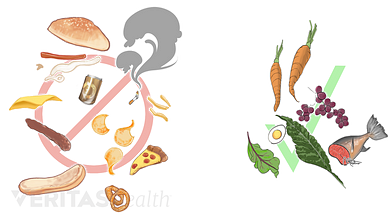
There are many things you can do to keep your diet full of nutritious and tasty foods, but there are also a lot of unhealthy healthy foods that you probably don't know about. Calories do not have to be the only thing that matters, but they can be a big help. The nutritional value and quality of the food is what is most important. You can make some diet changes by substituting processed foods for whole grain alternatives. Here are some of the best choices. And remember, eating a variety of different kinds of food is better for you than a single type of food.
Avoid sugary snacks and drinks. Sugary drinks and snacks that are high in fat and sugar can be harmful to your health. Most store-bought muffins are just cake in a muffin shell. Don't eat "healthy" frozen dinners. They're full of sugar and preservatives. The majority of fat-free, gluten-free desserts lack nutrients. Most so-called health foods are filled with artificial junk. Bananas and mangos, which are high in natural fiber, are great sources.
Choose healthy foods that are low in fat, sugar, or both. These foods are considered unhealthy because they are high in nutrients. Avoiding them is better than eating too many. You can enjoy a treat if you choose the healthier option. Organic and free-range eggs are some of the best choices. If in doubt, talk to your doctor. It's easy and simple to switch to healthier eating habits. It doesn’t have to take much effort.

Your diet should include a variety health foods. Eat more fruits and veggies than you usually do. They are healthier long-term. To reap all the health benefits from nutritious food, you don’t necessarily have to be a calorie-monster. There are many options to increase your intake of healthy foods without feeling hungry. You will lose weight and remain healthy if you eat healthy foods.
Although fast food chains may be trying to portray themselves as healthy, they should not be misled by the label that says "healthy". Sugar substitutes are available in many foods that claim to be healthy. These sugar substitutes can cause an increase in caloric intake, and even increase the risk of getting diabetes. Healthy eating habits include avoiding unhealthy foods and sticking to whole foods. There are many things you can do to make your food more nutritious. You just need to make healthier choices.
Plant-based meats are another common fake healthy food. They're not real meats. These foods can be made to look like meat and have high levels of fat and sodium. In other words, they're not really a good option for your diet. In order to avoid the potential dangers of these foods, you should stick to whole, nutrient-dense foods. It's crucial to find the right balance in your diet between healthy and unhealthy food.
Organic or raw food are a healthier option. Some of these are low in fat and are loaded with antioxidants. They're also rich sources of vitamins C- and A. They are low in calories and therefore a good choice for those with diabetes. Your doctor will recommend the best way to achieve the best results. These foods are best for your body. These foods can help you maintain a normal level of blood sugar.

Some of the most popular yogurts are not as healthy. Many of these yogurts have high sugar levels and are flavorful. You can find low-fat yogurt that has only 15 grams sugar per serving. This is still a lot. You can only get low-fat milk if you buy the unsweetened version. You can also choose non-fat frozen cream instead of icecream.
While you should avoid high-fat foods, you should not ignore the fact that they are also rich in fiber and vitamins. Choose bars with at least three grams of protein and low sugar. You want a healthy energy bar that has minimal ingredients and contains less than 10g sugar. This will help with weight loss and better health. It will pay off in the end!
FAQ
Why do we need to have a healthy lifestyle?
A healthy lifestyle will help us live longer and happier lives. Good nutrition, exercise regularly, good sleep habits, stress management and healthy lifestyle can help you avoid heart disease and stroke.
Healthy lifestyles will help us to cope with daily stresses better and improve our mental health. Healthy lifestyles will increase self confidence, and make us look and feel older.
Is being cold good for your immune system.
Cold weather can cause a decline in your immune system. Your body produces fewer white blood cell which fight infection. You will feel less pain if you are cold.
How much should I weight for my height and age? BMI calculator & chart
A body mass index calculator (BMI) is the best way to find out how much weight you should lose. A healthy BMI range is between 18.5 and 24.9. To lose weight, you should aim for a loss of 10 pounds per year. Simply enter your height, weight and desired BMI into the BMI calculator to calculate it.
This BMI chart can help you find out if or not you are obese.
How can I lower my blood pressure
The first thing you need to do is find out what causes high blood pressure. Next, you will need to determine what is causing high blood pressure. You can do this by eating less salt, losing weight, or taking medication.
It is important to ensure that you get enough exercise. You can also walk if you don’t have the time.
A gym membership is a good idea if you don't like how much exercise your doing. You will likely want to join an exercise group that shares your goals. It's easier to stick to an exercise routine when you know someone else is going to see you at the gym.
What are 10 healthy habits you can adopt?
-
Get breakfast every morning.
-
Don't skip meals.
-
Keep a balanced diet.
-
Get plenty of water.
-
Take care your body.
-
Get enough rest.
-
Stay away from junk foods.
-
Do some form of exercise daily.
-
Have fun
-
Make new friends
Do I need to count calories?
It is possible to wonder "What diet is best for me?" or "is counting calories necessary?" Well, the answer depends on several factors including your current health status, your personal goals, your preferences, and your overall lifestyle.
The Best Diet For Me: Which One Is Right?
My current health, my personal goals and lifestyle will determine the best diet for me. There are many diets out there, some good and some bad. Some work well for certain people while others don't. So what do I do? How do I make a good decision?
These are the main questions addressed by this article. It begins with an overview of the different diets today. Next, we'll discuss the pros and cons for each type of diet. We'll then discuss how to choose which one is best for you.
Let's first take a look at different diets.
Diet Types
There are three types of diets available: ketogenic, high-protein, and low fat. Let's briefly discuss them below.
Low Fat Diets
A low-fat diet is one that limits the intake of fats. This is done through reducing the intake of saturated fats (butter, cream cheese, etc.) They are replaced by unsaturated fats such as avocados, olive oil, and cream cheese. Low fat diets are often recommended to those who wish to lose weight quickly. This diet can cause problems such constipation as heartburn, indigestion, and even stomach pain. If a person doesn’t receive enough vitamins from their foods, this can lead to vitamin deficiency.
High Protein Diets
High protein diets reduce carbohydrates to favor of proteins. These diets have higher protein levels than other diets. These diets are meant to increase muscle mass, and burn more calories. They may not be able to provide sufficient nutrition for people who need it. They may also be too restrictive and not suitable for everyone.
Ketogenic Diets
Ketogenic diets also go by the name keto diets. They are high-fat and low in carbs and protein. They are commonly used by athletes and bodybuilders, as they allow them train harder and more frequently without getting tired. However, they must be used with caution to avoid nausea, headaches and fatigue.
Here are 7 ways to live a healthy lifestyle.
-
You should eat right
-
Exercise regularly
-
Sleep well
-
Get plenty of water.
-
Get enough sleep
-
Be happy
-
Smile often
Statistics
- According to the 2020 Dietary Guidelines for Americans, a balanced diet high in fruits and vegetables, lean protein, low-fat dairy and whole grains is needed for optimal energy. (mayoclinichealthsystem.org)
- According to the Physical Activity Guidelines for Americans, we should strive for at least 150 minutes of moderate intensity activity each week (54Trusted Source Smoking, harmful use of drugs, and alcohol abuse can all seriously negatively affect your health. (healthline.com)
- The Dietary Guidelines for Americans recommend keeping added sugar intake below 10% of your daily calorie intake, while the World Health Organization recommends slashing added sugars to 5% or less of your daily calories for optimal health (59Trusted (healthline.com)
- WHO recommends consuming less than 5% of total energy intake for additional health benefits. (who.int)
External Links
How To
What does the word "vitamin" mean?
Vitamins are organic compounds that can be found in foods. Vitamins are essential for our bodies to absorb nutrients from the foods we eat. Vitamins cannot be made by the body; they must be taken from food.
There are two types if vitamins: water soluble, and fat soluble. Water-soluble vitamins dissolve in water easily. You can find vitamin C,B1 or thiamine, B2 or riboflavin and B3 or niacin, B3/niacin, B6/pyridoxine, folic Acid, biotin and pantothenic Acid as examples. Fat soluble vitamins are stored in the liver and fatty tissue. Vitamin D, E, K and A are some examples.
Vitamins are classified based on their biological activity. There are eight major groups of vitamins:
-
A - vital for healthy growth.
-
C - important for proper nerve function and energy production.
-
D - Essential for healthy teeth and bones.
-
E - needed for good vision and reproduction.
-
K – Required for healthy nerves & muscles.
-
P - Vital for strong bones and teeth.
-
Q - Aids in digestion and absorption.
-
R - necessary for making red blood cells.
The recommended daily intake (RDA), of vitamins varies with age, gender and physical condition. The U.S. Food and Drug Administration (FDA) sets the RDA values.
For adults over 19 years, the RDA is 400 mg per day for vitamin A. For fetal development, pregnant women need 600 mg per day. Children ages 1-8 require 900 micrograms per day. For infants younger than one year, 700 micrograms are required daily. However, this number drops to 500 micrograms each day for children aged 9-12 months.
Children aged 1-18 years need 800 micrograms daily, while children overweight require 1000 micrograms per days. Children who are severely obese or underweight will need 1200 micrograms each day.
Children aged 4-8 years old who have been diagnosed as having anemia require 2200 micrograms of vitamin C per day.
2000 micrograms is the minimum daily intake for adults over 50 years old to maintain good health. Due to their increased nutrient needs, pregnant and breastfeeding women need 3000 micrograms daily.
Adults over 70 need 1500 micrograms daily, as they lose 10% of their muscle every ten years.
Women who are pregnant, nursing or breastfeeding need more than the RDA. Pregnant women require 4000 micrograms daily during pregnancy, and 2500 micrograms every day after birth. Breastfeeding mothers need to consume 5000 micrograms every day when breastmilk has been produced.